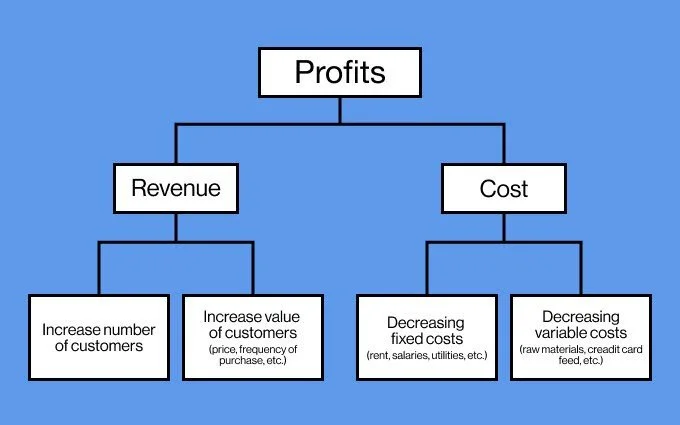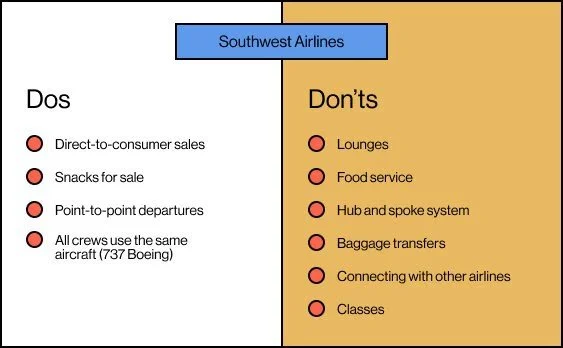How to become a more strategically minded designer?
By Alen Faljic
Have you ever been asked to think more strategically? If so, what does that even mean? What does being strategic imply? This is not an easy question to answer because there are many different interpretations of the meaning of strategy.
I frequently ask d.MBA students if they have ever been told to think more strategically and what they think people mean when they say that. It turns out that when designers are asked to think strategically, what they’re really being asked is to see the bigger picture. So, we either need to connect our work with someone else’s work, or we need to connect our project’s goal with some overarching company’s goals.
In fact, if you Google the term strategy, the definition is a “plan of action that aims to achieve a long-term or overall goal”.
But in business, strategy has a much more specific meaning. Business strategy is deciding what to do and what not to do. What to invest in and what not to invest in. It requires making hard trade-off decisions. These are the choices that compel us to either do X or Y. We can’t do both. Let me explain with a couple of examples.
Size and speed are typical tradeoffs in car design. Cars that are bigger and heavier are slower, but also more spacious and comfortable. Conversely, sports cars are usually small and light, allowing for fast acceleration and high top speeds. For example, McLaren’s Senna is a supercar that costs one million dollars but doesn’t even have air conditioning to save weight and improve the car’s performance.
Here is another example from the tech industry. Google’s strategy is software-first while Apple’s is hardware-first. Google’s software is designed to work well with many different platforms while Apple’s software is designed to work only with Apple hardware. The trade-off here is compatibility (Google) versus quality control (Apple). Google’s compatibility comes at the expense of controlling the user experience and vice versa. This fundamental trade-off decision affects all other business decisions at Google and Apple.
So, the business strategy involves making trade-offs with the goal to achieve a competitive advantage. A competitive advantage is something challenging to copy. It means that we make something that has so much value and is so complex to replicate that we can be profitable and have enough resources to reinvest and have even more impact.
So, what is the correct definition of strategy?
There is no right or wrong answer here. It depends on the context. When somebody asks us to approach a project strategically, we need to understand which one of the two broader definitions they are referring to. Do they want us to think about the bigger picture? Or do they want us to prototype, design, and test trade-off decisions?
We will have a look at both options. Let’s see how we can recognize what strategy means in our context and what we as designers should do in each situation.
Option 1:
The big picture approach
In most cases, when somebody asks us to be strategic, they are talking about seeing the bigger picture and understanding the overarching goals. That’s especially the case if you work on a smaller project within a large organization. In these situations, you need to understand how your project fits into the bigger picture.
To gain this strategic lens, we can use the designer’s superpower — empathy. The best way to figure that out is to talk to someone from the business side about the goals of our project. Usual suspects are product managers, C-level executives (in smaller companies, you may have access to them), and department leads. So, people who are responsible for certain goals or KPIs (Key Performance Indicators).
Here are a few questions you can use when talking to them:
What are the organization’s most important goals and metrics for this quarter/year? Why?
What are the project’s most important goals and metrics? Why?
How will we measure these goals?
What obstacles do we foresee in achieving these goals?
What resources are available to us for this project?
Use these questions as a starting point and then dig deeper once you hear interesting nuggets of information.
For example, let’s say you are staffed on a project that will redesign new users’ onboarding. Sounds simple enough, right? We need to make the onboarding better so they will get more value from the product and use it long-term, right?
But imagine that the real reason this project was launched is something more unexpected. What if there is a new competitor on the market that has copied our onboarding and we need to redesign it to show how we are different. That changes the brief and complexity. We had onboarding that worked well from a conversion perspective. However, our new problem is conveying differentiation without compromising conversion.
There is a complementary tool that can help us understand how our work fits into organizational goals. A profit tree is a visual representation of the goals in our organization. It breaks down organizational goals on revenue and cost sides. It shows us that every project is fundamentally about either increasing revenue or decreasing costs.
So, whatever we do as designers should ultimately lead to increased revenue or decreased costs. And a profit tree helps us illustrate how our work fits into the bigger picture. Specifically, it breaks down companies’ two basic goals into four basic business levers:
Attract more customers
(conversion rates, referral rates, etc.)
Increase customer value
(price, purchase frequency, and retention)
Decreasing fixed costs
(rent, utilities, etc.)
Decreasing variable costs
(marketing, materials, hosting, etc.)
A profit tree is a visual representation of the goals in our organization.
So, next time somebody asks you to think strategically, use the big picture approach. Unless they have a business strategy in mind. In that case, we need an alternative approach.
Option 2:
Working on a business strategy project
If you get staffed on a high-level strategic project, you’ll need to use a different process. In that case, you should be thinking about business strategy, which involves making trade-off decisions.
The way to recognize such projects is again to understand their goals. If the primary goal is to create a competitive advantage, you need to use trade-off thinking. A few examples of strategic projects include designing product offering plans, branding exercises, and defining our target market.
When you find yourself on such projects, here is a four-step process that you can follow:
Step 1:
Deeply understand the cost drivers of your company, product, or service. Find out what companies in your space are investing in. For example, airlines’ cost drivers include the aircraft they fly with, the airports they fly from, the seats they provide, the legroom, the food services, the lounges, in-flight entertainment, etc. These choices affect the airline’s cost structure. Low-cost airlines can offer flights at cheaper prices precisely because they eliminate investments wherever possible. They have smaller legroom, no food service, no lounges, no in-flight entertainment, no business class, etc.
Cost drivers are unique for each industry. For example, in the hotel industry, cost drivers are a hotel’s location, room size, furniture, reception staff, cleaning staff, restaurant, concierge, etc. These are all factors that contribute to a hotel’s costs and are hence investments.
Step 2:
Once you understand the cost drivers, you need to create trade-off scenarios. Let’s imagine we are designers at a hotel chain and we need to create an overall concept for our hotels. So, if we were building a hotel for business travelers, we could create one scenario with a hotel chain located in city centers that consequently have small rooms but a great sleeping environment (beds, linen, etc.) And the other scenario could be a hotel chain on the outskirts of cities centers but with large rooms and all accompanying hotel amenities such as pool, gym, saunas, and concierge service.
It is important that each scenario has pros and cons. Each option needs to have clear advantages and disadvantages. That’s crucial for our next step.
Step 3:
In the third step, we need to test our scenarios with potential customers. Let’s continue with our hotel example. We could say: “What would you prefer? Staying in a hotel that is located in a city center but has a tiny room but a great sleeping environment? Or would you rather book a hotel on the outskirts of a city but with large rooms and all accompanying hotel amenities such as pool, gym, saunas, and concierge service?”
You can test your trade-off scenarios with simple sketches.
It’s essential that we don’t just ask what scenario they would choose but also why they chose it. There are times when interviewees say they prefer scenario A but their why uncovers that they would actually pick scenario B. Asking for why will give us additional information which will help us take the trade-off decision and eventually design a solution.
Step 4:
In step four, we present a coherent offer based on a trade-off scenario that interviewees chose. Using this, we create a list of activities or features we should develop to deliver on this promise and what we should invest in from a business perspective.
As mentioned earlier, strategy is about choosing what to do and what not to do. So, we should not forget about the second part. A good strategic recommendation also has a not to do list. Here is an example from Southwest airlines, a company that pioneered the low-cost airline category.
Every (business) strategic recommendation should include a list of do’s and don’ts.
By the way, if you’re interested in coming up with a strategy using the Sprint methodology as a foundation, at the d.MBA we have created a Strategy Sprint, where the core strategic ideas can be designed and tested in just a few days.
What do you mean by strategy?
The bottom line is that strategy is one of the most commonly misused words in business and design. So, when you talk about strategy, make sure you have a common understanding.
When somebody talks about the strategy I always ask them “What do you mean with strategy?” At first, they look at me puzzled. But once they attempt to explain, I at least understand what we are discussing. (Even though I don’t agree with their definition most of the time). A common understanding of any topic is a basis for good collaboration. So, don’t be afraid to ask. There are no dumb questions.
It’s essentially practicing what we are great at — empathy. Acting strategically will be easy as long as we transfer our empathy to the business user.
Originally published on Medium - Bootcamp Publication.



